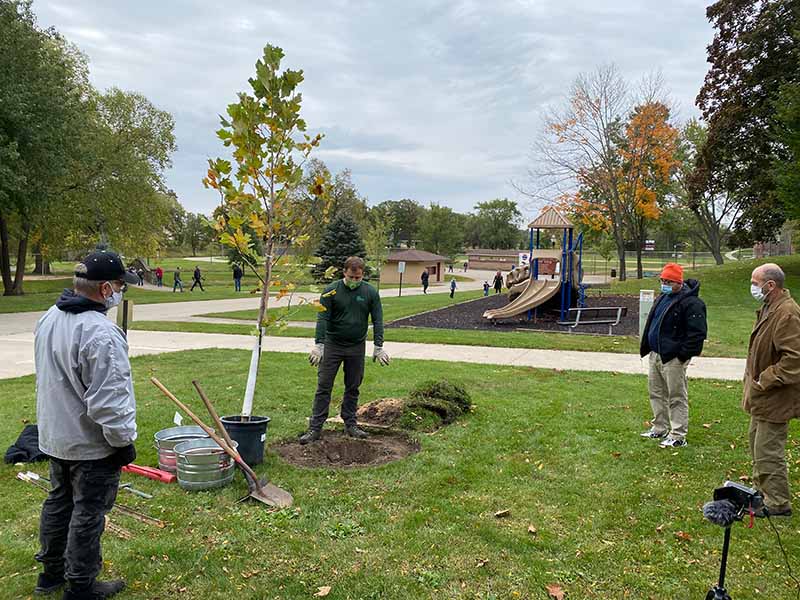Nathan Schuettpelz is a registered consulting arborist at Wachtel Tree Science.
Who are you/what is your role?
I am the consulting department manager with Wachtel Tree Science. We provide tree care, plant healthcare, and consulting services for municipalities in Wisconsin. I am also the current president of the Wisconsin Arborist Association, whose mission is to improve the practice of arboriculture and increase public appreciation of trees and urban forests.
What does a healthy urban tree landscape look like?
A healthy urban forest is a diverse forest that has multiple tree species as well as diverse structures and age classes. It has a high percentage of young, healthy, more vigorous types of trees that will replace older tree specimens as they age and phase out. Trees in urban environments deal with extremes in temperatures, precipitation, and swings in exposure. This leads to shorter tree lifespans.
With a warming climate, there is an opportunity to introduce trees species that are more acclimated to growing zones that are south of us. We are also aware that increasing temperatures may provide an opportunity for new pests and diseases or exacerbate the effects of native pests and diseases. More diverse and vigorous young trees can better withstand these changes.

Can trees help with storms and flooding in urban areas?
Yes, there is a wealth of knowledge about this now. We know that densely populated urban areas have this urban heat island effect, and trees in urban spaces contribute to lessening these effects. They create shaded environments on concrete surfaces to reduce the felt temperature. Trees can also create canopies that intercept rainfall, which reduces the effects of erosion and compaction from extreme rain events. Their roots also help soak up some of that rainfall.
What are some strategies you promote to increase climate resilience?
Climate change is not at the top of the list with municipalities in regards to influencing management decisions. What is at the forefront, I would say, is reducing risk. Right now, everyone has been and is still dealing with the loss of our ash forests due to the emerald ash borer. Communities are asking, “We have hundreds if not thousands of standing dead ash trees — what is our liability? What do we have to do to reduce the risk? And what can we do to prevent this from happening again?”
The challenges we face around the loss of our ash forests can be traced back to the loss of our elm forests back in the 1950s through the 1970s. We replaced one monoculture with another. This made sense with what was known and available at the time. Ash do very well in urban centers. They grow well across a variety of conditions and sites. They establish easily and grow into beautiful trees. The main strategy that we recommend now is to: diversify, diversify, and diversify.
Diversifying our urban forests will be challenging. Nursery stocks are low, caused by ripple effects of the recession of the early 2000s. Reduced construction limited the demand for trees, which then reduced future planned nursery stock. As plant inventory rebounded, we then got hit with the emerald ash borer and so we’re dealing with all these public trees that are lost and municipalities clamoring for available nursery trees. We are experiencing a boom in construction, which is also consuming the available nursery stock.
One strategy to respond to the low nursery stocks are grow contracts. This type of contract provides an upfront down payment on future orders for a municipality. The nursery gets the money up front that they need to establish the tree populations, and the municipality benefits from guaranteed orders. The nurseries have developed innovative growing techniques to get trees to market sooner. Historically burlap trees were the way to go, but they take time. Now nurseries are implementing different types of container-growing systems which gets trees to marketable size sooner.
Can you comment on social justice issues and urban forestry?
We are seeing an increased focus in the research of the benefits of trees in urban centers. Research has shown that trees can be linked to reduced crime rates and improved overall human health. The health improvements cover mental health, recovery from operations, and reduced reliance on medications. The medical field is more commonly recommending time in the outdoors and green spaces. Those are good reasons to justify increased forestry budgets and increased planting.
Municipalities in Wisconsin have had success focusing on planting trees in lower income neighborhoods or neighborhoods of greater needs. To accomplish this task, they do geospatial mapping of the urban canopy and link the changes in urban canopy across a community to data they have on crime rates, incomes, and other data to identify areas that need and would benefit from trees.
Do you have hope for urban forests?
I have a lot of hope for our urban forests. When I entered the world of urban forestry and arboriculture, there was pushback from my close family. “What’s an arborist? How is this going to benefit you? Will you even be able to make it a career? People care about trees but not that much.” Nowadays, I run into a lot more people who understand who I am when I say I’m an arborist. I get a lot of excited questions about their own trees. This shows, just in the short span of my career, how much there has been increased public awareness of our urban forests and how those urban forests benefit the community.
The views and opinions expressed in this interview are those of the authors and do not represent official policy or position of the University of Wisconsin-Madison or the Wisconsin Initiative on Climate Change Impacts.
For More Information
Nathan Schuettpelz, RCA #732
Consulting Department Manager
ISA Certified Arborist Municipal Specialist
Wachtel Tree Science
Office: (262) 538-1900
Mobile: (262) 337-3984
Fax: (262) 538-1412
nates@wachteltree.com